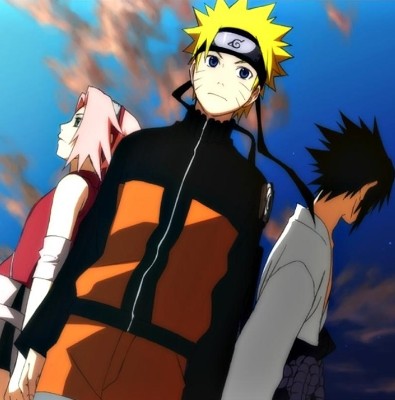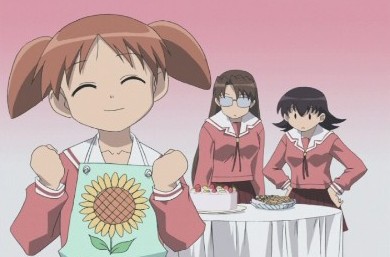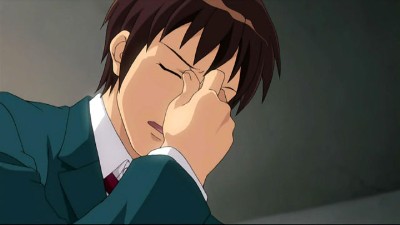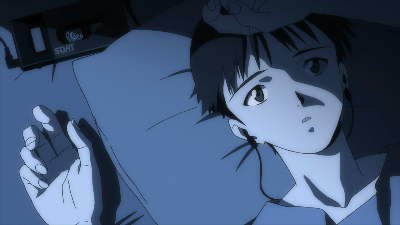
One of the unique ways in which anime is written when compared to other forms of TV and movie entertainment, is how often the audience is given insight into a character’s inner thoughts and feelings. There are many examples of anime from a variety of genres where viewers get to hear what the character is thinking to him/herself (while the other characters cannot hear it). I believe that this method of letting the audience inside characters’ inner thoughts is a big part of anime’s appeal, especially in the character development department…
While revealing characters’ unspoken thoughts to the audience isn’t something that’s only found in anime, it’s a lot more common in anime and is often a driving point of narrative flow and audience appeal. This is simply speculation on my part, but I believe anime’s popular narrative structure of letting the audience hear what characters are thinking to themselves, whether for on-the-spot matters or self-enlightening musings, has roots in the popularity of Japanese I-novels, with their emphasis on naturalism in literature and portraying a realistic view of the world through language. Being able to hear what a character is thinking at times, in addition to what they’re saying, helps build a more realistic, personal picture of the character than just speech and actions alone.

Shonen anime such as Naruto let us inside characters’ thoughts quite a bit, sometimes for trivial things and sometimes for really important things. Often it’s just simple thoughts like “How am I going to beat this guy?” or “Damn, he’s really strong.” While these may not seem like much, and could just as well have been said out loud rather than thought, I believe revealing even these trite inner thoughts increases our sympathy for the character because we know exactly how much they’re stressing about things rather than just guess it through their actions and facial expressions. Going back to the I-novels and naturalism, these thoughts show us that the character is reacting to things in a natural way, and we in turn can get inside of that through their thoughts instead of just being an observer. Other times, the characters will go into long inner monologues, often broken up by flashbacks, where they gain much philosophical insight into themselves and others around them. I’ve noticed that shonen and other action anime are written this way, with two different types of character thoughts – one for simple matters that are happening at the moment, usually when the characters are in a battle and are narrating how they feel about it in real time, and others that are longer and more complex where they delve deep into their all-encompassing feelings.

On the opposite end of the spectrum, revealing a character’s inner thoughts to the audience can also be used for a comedic effect, as is the case for Azumanga Daioh. Slice-of-life anime don’t use it as much as other series, since their appeal comes from character interactions rather than what characters are thinking to themselves, but it can be used to further impact a joke. A given gag in AzuDai could get an increase in comedic effect if the character thinks the punchline to herself rather than speaks out-loud to the other characters (but usually in AzuDai’s case, the latter is funny as well XD)

Haruhi is a special example in that we don’t get to know the inner thoughts of any other character but Kyon. The anime version of the series retains the strictly first-person view of the novels, only letting us see what Kyon sees and hear what he hears. Our entire perception of the events, setting, and other characters is dependent on what he tells us about them, though he’s often an unreliable narrator. The compromise however, is that it’s a unique experience and his descriptions are refreshingly witty, insightful, and often filled with ambiguities for fans to debate. Other first-person anime, such as Clannad and others based on dating games, are similarly confined to the perspective of just one character. This may seem like it limits character development when compared to shonen series that usually “take turns” getting the inner thoughts of all characters revealed, but developing a character solely through the eyes of another has its own type of charm.

Evangelion is probably the most common anime series fans would think of as far as characters’ inner thoughts being revealed. But what I’ve noticed about Eva and other mecha series is that characters’ inner thoughts are usually revealed all at once in certain isolated instances rather than little unimportant bits. In Eva for example, we don’t get to hear too much of the Eva characters’ thoughts for “at the moment” matters such as “That’s a scary Angel!” or “How are we going to beat it?” in the same way it’s done for shonen titles. But then we have episodes like the final two of the TV series that are nothing but revelations of all the characters’ deepest and darkest inner thoughts.
We’re so used to being able to get inside anime characters’ heads and know what they’re thinking that we often take it for granted. Try imagining some of your favorite series with all unspoken dialogue taken out. Would the story not be able to make sense that way? Would characters lose their development? Maybe to some, whether a character speaks or thinks something isn’t a big deal, but I find it interesting to wonder about ;)
I don’t know, due to the fact that most characters have inner monologues these days, it would be nice to have a show where it left a lot of the thinking to the reader. I’m not sure if it would be successful or if it would work, but it would be a nice change of pace.
There are a lot of anime where the characters rarely have inner monologues, or just have them for obvious things like what I mentioned with shonen series. I can’t think of a ton of examples at the moment, but I know I’ve seen some. Just off the top of my head, I don’t recall hearing much of any character inner thoughts in K-ON =P
Yeah, i agree mainly because i like to think which is a bit of an odd thing to say but it’s true. So an anime that maybe gave you either a lot of things to figure out on your own or had you guessing what the character was feeling or thinking would be nice.
bye.
–End–
I think this is one of those things which animation can get away with better than live-action, because it doesn’t look real. You can’t hear people’s thoughts in reality, so if you’re looking at something which looks like reality and you hear someone’s thoughts, it’s a bit weird. But once you’ve thrown the “reality” look away, it’s not a problem any more.
I agree with Logopolis’ view on this to a certain extent. The one instance in live action where I think the inner monologue works well is in comedy, such as in the J-drama HanaKimi. In fact, it reminds me a lot of the comedy to which you refer in Azumanga Daioh.
I would imagine that inner monologues would be used in more Japanese live-action productions than Western ones, perhaps because of the aforementioned influence from naturalism, and of course, anime/manga. From what I’ve heard, the Japanese live-action TV/film industry isn’t as successful as anime and manga, so maybe they’d want to borrow some of the latter’s techniques.
That’s an excellent point. Since anime is such a visually spectacular medium, and a lot of emphasis is put on stylized character designs and expressions, hearing a character’s thoughts while looking at him/her doesn’t seem as weird as it would looking at a real person.
Good point.
bye.
–End–
Good point, and very true. But it can be done in serious real-action movies, it’s just not explored much. The old movie “Dune” is a good example. We get to hear peoples inner thoughts and it helps flesh them out a lot. I wouldn’t mind if that was used more, it could help some kind of movies a lot more.
Agreed. My mother was watching an old show yesterday (now in technicolor!), and as I was walking by I noticed that the main character was having an inner monologue. She was standing on-screen, making facial gestures to go along with her thoughts, while people walked by in the background for several minutes. I don’t know why exactly, but it was kinda weird. Maybe because the facial gestures, though only slightly exaggerated, looked out-of-place in comparison to anime … although, if she had just been standing there like a lump while her thoughts were played out, that would have been even weirder.
Inner dialogues is probably one of the defining traits to anime in general, with rather few exceptions. The ones that do stay away from inner dialogues, though, tend to be some of the more intriguing series out there. Baccano would the first one I could name off the top of my head, which really focused in on the idea of “perspective”, as opposed to enlighten us on the thoughts of the characters (and it turned out great).
When it comes down to it, the “inner dialogues” is part of the storytelling, and the degree to which they are used changes the way in which the audience perceives things, and how events are “flavored” towards a certain bias or not.
It’s weird that I can’t recall a concrete example of an anime with no inner dialogues – I can think of many that use them a lot, and I know that there are many that don’t, but I can’t say for certain which ones unless the series is fresh in my mind. I feel like even for ones where I know inner dialogue is hardly used, some instances crop up anyway. Like I mentioned, they’re rarer in slice-of-life series because of the nature of these shows and K-ON is one series I can say for certain doesn’t have any.
But yes, as you say, it’s a story-telling technique that happens to be used a lot in anime. As I said to Logopolis above, anime’s emphasis on visually attractive character designs makes inner dialogues click better than with live-action.
Wow. That makes a lot of sence…. However i have to agree and disagree on that one piont where you said “the ones that do stay away from inner dialogues, though, tend to be some of the more intriguing series out there”. It’s true that becuase certain anime doesn’t have the innner dialoge that it leaves more room for us as the audiance to be shown that emotion rather than having it expressed in their thoughts; and sometimes actions do speak louder than words. But I also must disagree because there are plenty of good anime that use the inner dialoge or thoughts of their characters to make the character in a way more human. They do this by showing us how they see things and thier doubts, fears, and hopes and have become successful because of it. Either way it was a very interesting comment and definatly something to think about. -thanks
bye.
–End–
This is common in a lot of books too and is becoming a bit more widely used in superhero shows. But, it definatly does help with the character developement as character developement is an important part of anime as well as in books. Besides being able to tap in the characters thoughts definatly helps us identify with the character more…. If only we could do that in real life.
bye.
–End–
Right, it does make characters more appealing because we get to go into their heads and find out exactly what they’re feeling, something we can only guess at for people in real life =/
Don’t have much to say, but I wanted to let you know that I enjoyed this post (as always). :)
Thanks for reading, glad you enjoyed it~ ^_^
This is one of the reasons I love anime so much :) It just brings you closer to the characters in a way that only a book can do. Haruhi is an excellent example. Some of the arcs are so close to the books, that it makes the anime probably even better than the book. It provides everything the book did, plus a great visual experience. Double win.
That’s where many western movies actually fail. They will try to bend over backwards to try to make an actor express something, that probably many people will totally miss in the end. So in western movies, a book will always be better, and provide more detail. Although there are some exceptions. “Meet Joe Black” is a movie that expressed everything so well, that the style actually reminded me of anime.
Anyway, nice post, and you are completely right. Having insight into what a character is thinking is a great way to develop things in the direction they want them to go. Just imagining Haruhi with all of Kyons thoughts removed… Nah, can’t even imagine it…
I haven’t seen that many Western movies, but from what I have seen, it does seem like the focus is on “acting” rather than choreography of how the dialogue is presented, i.e., spoken in a character’s mind or in a narrative style (like Kyon’s dialogue). I’ve also noticed that scenes in Western movies go a lot faster than in anime, with lingering on any particular scene (or character monologue) kept to a minimum. I believe this has to do with Japan’s interest in wabi-sabi or “the beauty and transience of the moment.”
While I generally enjoy the inner dialogues of anime characters there are times that I feel it breaks the “show don’t tell” rule, particularly in the aforementioned shounen scenes. I recall watching an episode of Soul Eater a few weeks ago where the main character’s inner dialogue essentially narrated the action and I couldn’t help thinking, “I just saw this, why are you telling me?” I just found it a bit distracting.
The prevalence of inner dialogue in anime, though, is a good point, and, like I said, one I usually enjoy. Thanks for the post!
Thanks for reading~
I agree that too much inner dialogue for obvious things can get annoying. Like your Soul Eater example, when the characters narrate in their minds everything that happens in a battle, like “What kind of power is that?”, “How can he dodge that?”, “What? It’s not working!”, “I have to finish this fight soon or else…”…yeah, too much of this is unnecessary XD But for the most part I think it’s a good thing.
Sometimes I don’t like inner dialogues because it certainly overpowers the other character’s thoughts. As a result, less character development for the other characters. Other than that, I find inner dialogues helpful especially when it comes to understanding a story and relating more to the lead character’s perception–which is pretty much the story itself.
I personally find this trend to be one of the more annoying aspects of anime. It’s boring, it has no tact… It’s like having someone read you the movie summary from the back of the box. Most of the time, they are pointing out something that is completely obvious and I have no respect for a series that has to “tell” me how it is as opposed to show me in one creative fashion or the other. No. This does not include flashbacks. Pet peeve # 2. Not to mention, not every character needs some huge backstory. I can easy appreciate them as their present selves. I don’t want a 1o minute cut scene of them staring out a window or brushing their hair. They are trying to force you to relate to the character and it simply does the complete opposite. Not to mention, the range of emotions portrayed physically in anime is stunted. It’s either blank or some generic symbolic emotives. It’s no wonder they’d have to TELL us how they feel. I love my share of anime, but a lot of it outright blows anymore. It’s repetitive, sloppily animated and obnoxious.